<< Previous | Displaying results 6651-6700 of 6768 for "" | Next >>
Salek Liwer (center) with friends at a Dror Zionist youth movement seminar in the Bad Gastein displaced persons camp in Austria, 1946.
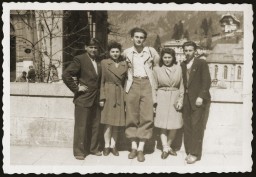
Jewish DP David Bromberg poses at the entrance to a barrack in the Ebensee displaced persons camp on October 30, 1946.
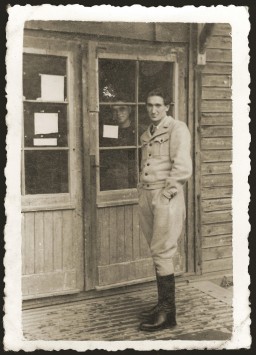
After World War II, the Rothschild hospital in Austria was primarily concerned with the rehabilitation of sick displaced persons. It also served as a lager for political prisoners and as a hostel for 600 refugees.
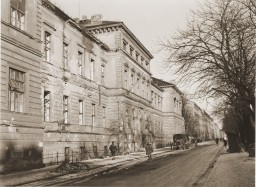
Jewish DPs (displaced persons) celebrate at a banquet at the Rothschild Hospital DP center.
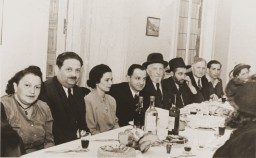
Jewish DPs from the New Palestine displaced persons camp in Salzburg, Austria, gather around a memorial dedicated to the Jewish victims of the Nazis. Among those pictured is Moniek Rozen (third from the left), Kazik Szancer (fourth from the left) and Rela Szancer (fifth from the left).
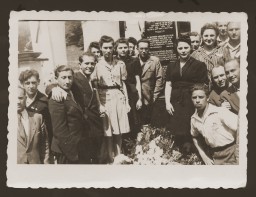
Displaced persons (DPs), Lusia Gliklich (left) and Andzia Dell, stand beside the sign in front of the Düppel Center DP camp, also called Schlachtensee.
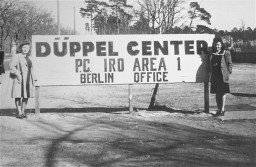
This report card was issued to Regina Laks, a fifth-grade student at the Herzel Hebrew Public School at the Düppel Center displaced persons camp.
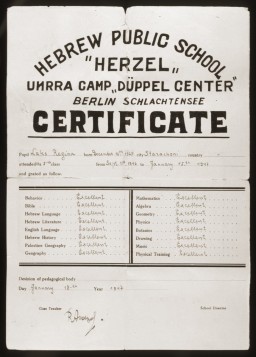
This identity card was issued to Henryk Lanceter at the Fürth Displaced Persons Camp in Germany.
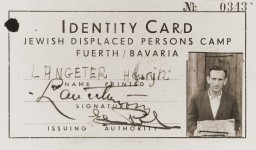
This identification card was issued to Sima Wajner, a Jewish resident of the Heidenheim displaced persons camp. The card identifies her as a former concentration camp inmate who had been imprisoned in the Stuffhof camp during the Holocaust. Card dated January 23, 1947.
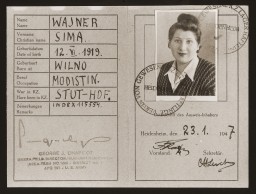
Jewish displaced persons (DPs) and American soldiers at the Heidenheim DP camp, circa 1946–1947. Leon Kliot (Klott) is standing on the far right, third from the top.

Young Jewish displaced persons (DPs) on a street in the Lampertheim DP camp, circa 1946–1948.

Group portrait of Jewish displaced persons (DPs) in the Leipheim DP camp. From left to right are an unidentified couple, Rubin Kaplan, Zalman Kaplan (cousin), Dwora (cousin) and her husband Eli Flaks, and their infant, Pearl.
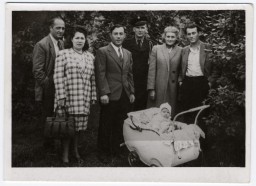
Bialik kindergarten students pose together in the Mariendorf displaced persons (DP) camp, circa 1946–1948. The children hold a banner that reads, "Ch, N. Bialik Kindergarten." A portrait of Theodor Herzl hangs on the back wall. Above the portrait is is a Hebrew banner that reads "Our children, the future of our nation." Benjamin Markowicz is in the fourth row, second from the left.

View of the Mariendorf displaced persons (DP) in Berlin, Germany, 1946–1948.
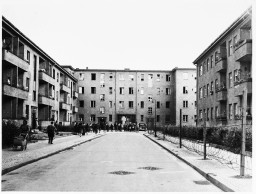
Jewish displaced persons (DPs) converse on the streets of the Neu Freimann DP camp, circa 1946–1948.The photographer, Jack Sutin, lived at the camp with his family and worked as a camp administrator and photojournalist.
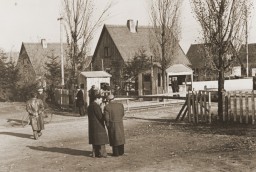
Dental technicians prepare molds at the Neu Freimann displaced persons (DP) camp, circa 1945–1949. Neu Freimann had its own dental treatment facility. The photographer, Jack Sutin, lived at the camp with his family and worked as a camp administrator and photojournalist.
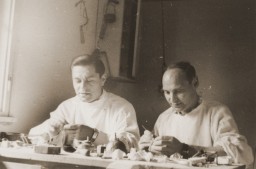
Elementary school-age members of Hashomer Hatzair in the Stuttgart displaced persons camp, circa 1946–1949. Lova Warszawczyk is standing in the center.
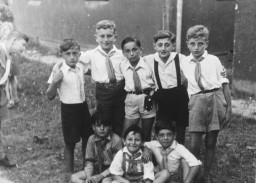
Henry Brauner (center) with his wife, Esther (second from right), pose with three friends in front of the entrance to the Stuttgart West displaced persons (DP) camp, 1945.
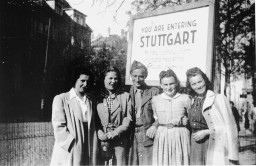
A view of the housing for Jewish displaced persons (DPs) at the Wetzlar DP camp in Germany, September 9, 1948.
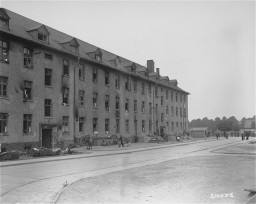
Leaders at the Wetzlar displaced persons (DP) camp hold a meeting to discuss current happenings and improvements for the camp, September 9, 1948.
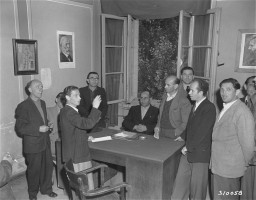
Men in the Ziegenhain displaced persons (DP) camp demonstrate on behalf of free immigration to Palestine, circa 1945 1948. Their banner expresses their wish to go to Israel.

Jewish displaced persons (DPs) enter the main gate of the Ziegenhain DP camp, September 1946.
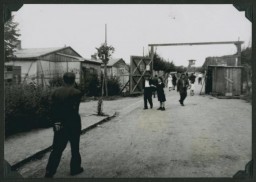
Portrait of siblings Saba and Julek Fiszman after their reunion in Santa Maria di Bagni, Italy, March 1946. Members of the Fiszman family had been separated over the course of the war. While at the Foehrenwald displaced persons (DP) camp, Saba learned from a Jewish Brigade Officer that her brother was in Italy. She traveled to Santa Maria di Bagni, where there was a DP camp, to meet him.
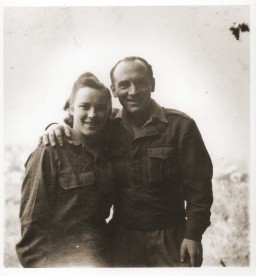
Abraham Morgenstern, right, stands in front of a sign marking the entrance to Bari Transit displaced persons (DP) camp in Italy, circa July 1947.
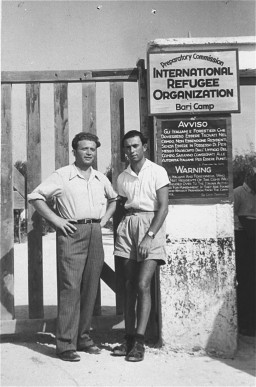
Jewish displaced persons (DPs) pose outside of a barracks in the Bari Transit DP camp in Italy. Among those pictured are Izidor and Tauba Schachter with their baby Miriam Schachter (now Enright), on the far right, and Etta Gipsman, on the far left.
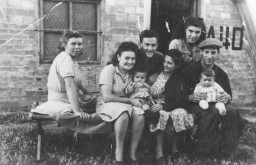
Edward Arzt, a Jewish displaced person (DP), stands at the entrance to the Cinecittà DP camp in Rome, Italy, 1947. Arzt and his family lived in the camp for three years before immigrating to the United States.
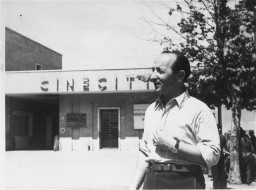
Ursula Tenenbaum, a Jewish displaced person (DP), watches her daughter, Katja, in the Cinecittà DP camp in Italy, June 1945.
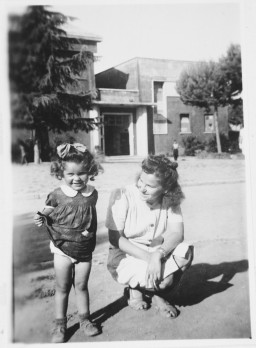
Jewish teenagers study electricity at a vocational ORT (Organization for Rehabilitation through Training) school in the Cremona displaced persons (DP) camp, Italy, 1945–1947. Shie Zoltak is standing on the far left. Standing on the far right is Shie's uncle, Abraham Lisogurski, who is the instructor.
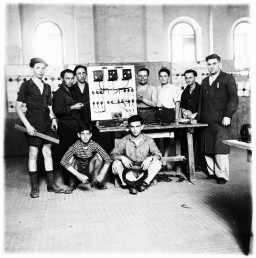
Two women and a child stand with metal bowls in front of a soup kitchen in the Cremona displaced persons (DP) camp in Italy, 1945. Pictured are Zelda Leikach and her daughter, Masha, with their friend Hinda.

Szyja Faktor, his wife Sala, and their daughter Frieda pose for a photograph while living in the Rivoli displaced persons (DP) camp in Italy, circa 1947–1948. During the war, Szyja, a Polish citizen, had briefly been held by the Germans. He escaped to the Soviet Union, where he stayed until 1945.
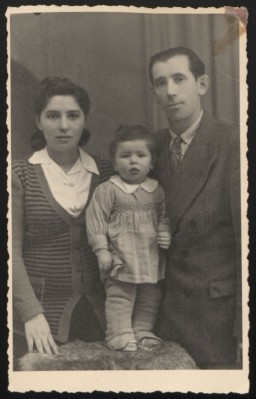
Austrian and German Jewish displaced persons (DPs)—who had survived the war in Albania—pose aboard a British ship taking them to the Tricase DP camp in Italy, September 28, 1945.
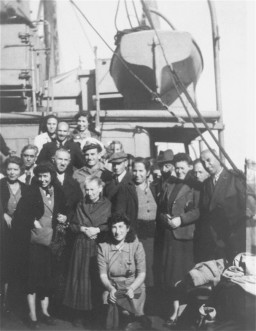
Diploma issued by the International Refugee Organization (IRO) certifying that Naftali Froimowicz was trained as a shoemaker in Turin, Italy on November 14, 1949. Froimowicz lived in several displaced persons (DP) camps in Italy after the war.
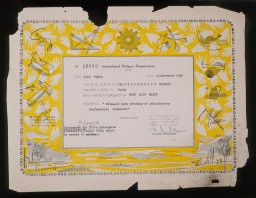
Group portrait of children and adults at the Hebrew school in the Gabersee displaced persons (DP) camp in Germany. Among those pictured is Bronia Spielman (front row, second from the left), circa 1946–1949.
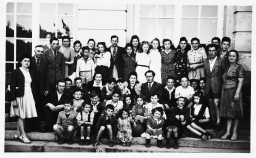
Three couples pose with their babies in the Gabersee displaced persons (DP) camp in Germany, 1947. In the center are David and Bella Perl (later spelled Pearl), who met and married after the war, with their daughter, Rachel. During the Holocaust, Bella Scheiner and her family were deported to Auschwitz. From there, she was sent to forced labor at Reichenbach, a sub-camp of Gross-Rosen. Bella met David—who had lost his wife and child during the war—while working at a photography studio after…
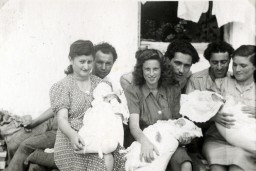
Laurette Cohen (front row, far right) poses with her students at an Alliance Israelite School in Morocco. 1935. Laurette was born in Oran, Algeria, 1911. In 1932, she married Prosper Cohen (born in Meknes in 1909). They were both teachers for the Alliance Israelite Universelle Schools in Morocco. Their daughter, Mathilde, was born in Tangiers on August 31, 1933. Before 1939, the family lived in Meknes and Fez. Later, Laurette and Prosper were sent to teach in other different locations where they were…
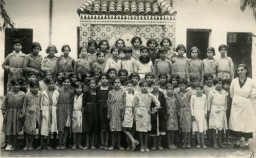
Prewar wedding portrait of Reine and Yishua Ghozlan in Constantine, Algeria, on March 29, 1932. The couple experienced antisemitism in the prewar years, and in 1933 Reine and Yishua survived a deadly pogrom by hiding with French Christian friends. After the start of World War II, Yishua was thrown out of his position in the post office. Reine, Yishua, and their children were evicted from their apartment.

Reine (seated in window) and Yishua Ghozlan (standing) were married in Constantine, Algeria, on March 29, 1932. They are pictured here with two of their parents. The couple experienced antisemitism in the prewar years, and in 1933 Reine and Yishua survived a deadly pogrom by hiding with French Christian friends. After the start of World War II, Yishua was thrown out of his position in the post office. Reine, Yishua, and their children were evicted from their apartment.
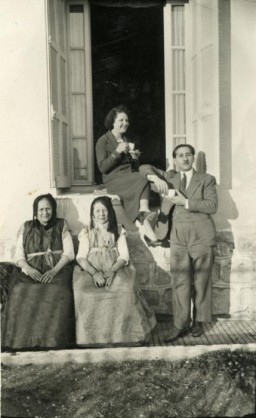
Joseph Roger Cheraki poses in the uniform of an Algerian soldier, ca. 1935. Joseph met Elizabeth Seiberl, and they married on October 27, 1936, in Algiers. In 1941, Joseph lost his job, their son Alfred was expelled from school, and they later had to sell their house. In 1942 Joseph, Elizabeth, and their sons Alfred and Jacques had to wear the yellow star. Boys threw stones at Alfred and Jacques. Joseph was sent to a forced-labor camp for a few months. He was eventually released. In 1946 the family…
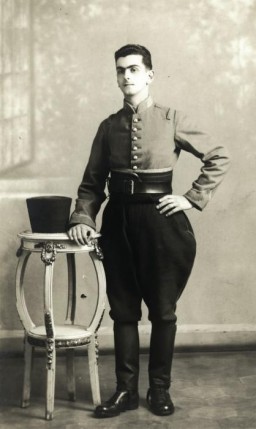
A group of Tunisian schoolgirls wearing aprons. Nadia Cohen is in the first row, third from the left. Tunis, Tunisia, ca. 1930-1935. Nadia Cohen was born on January 17, 1924, in Tunis. Nadia's parents came from Orthodox households, but her father left the yeshiva at the age of seven to study Italian, Arabic, and accounting in a French school. In 1938, Nadia was sent to a boarding school in France. She returned home for a visit in the summer of 1939 but could not return to school that fall due to the…
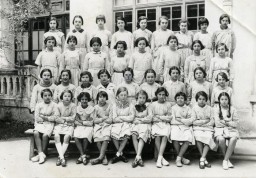
Terese Cohen, a Tunisian Jewish women, poses with her two children, Nadia and Marcel. Immediately after the Allied landings in Algeria and Morocco, the Germans occupied Tunisia. After the occupation, an SS officer came to the Cohen's house and confiscated everything leaving only the table and chairs for the Germans to use. They gave the family 24 hours to pack and leave and then expropriated the home to use as a barracks for soldiers.
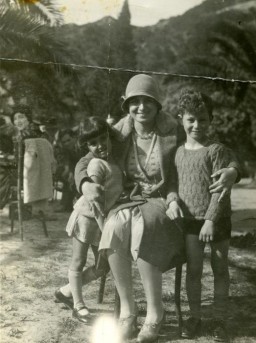
As a German soldier looks on, Tunisian Jews are forced to sweep the street and move a wooden crate on a hand cart. Tunisia, 1942-43. Photograph courtesy of Bundesarchiv, German Federal Archives
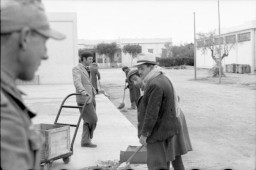
Sami Dorra working at dam construction in the Im Fout labor camp. The camp was approximately 59 miles southwest of Casablanca, and housed a group of foreign workers. Im Fout, Morocco, 1941-42.
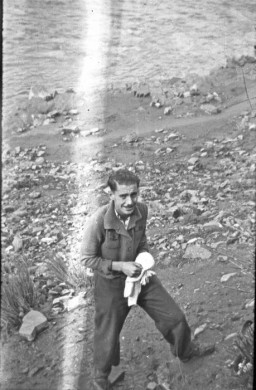
An unidentified worker walks by the railroad tracks at the Im Fout labor camp in Morocco. Living conditions were harsh in the camp, and many of the workers fell ill with typhus. Im Fout, Morocco, 1941-42.
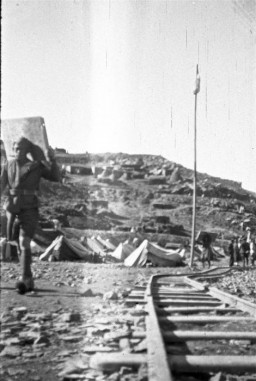
View of the dam being built by forced laborers from the Im Fout labor camp in Morocco. Photograph taken 1941-42.
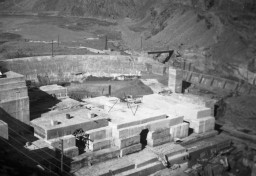
A German Jewish prisoner named Rosenthal pushes a cart in the stone quarry of the Im Fout labor camp in Morocco. The camp housed a group of foreign workers, many of whom fell ill because of poor living conditions. Im Fout, Morocco, 1941-42.
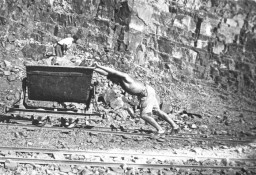
Close-up portrait of two prisoners in the Im Fout labor camp in Morocco. The camp was approximately 59 miles southwest of Casablanca, and housed a group of foreign workers. Many of the prisoners fell ill because of poor living conditions in the camp. Im Fout, Morocco, 1941-42.
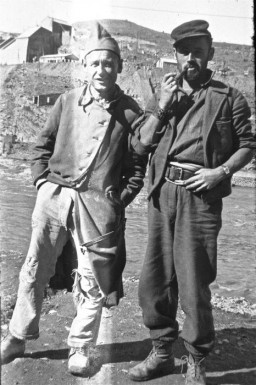
This photo was taken during the journey of Bluma (Kleinhandler) and Zygmunt Godzinski from Poland to Argentina. Casablanca, Morocco, 1946.
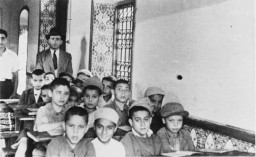
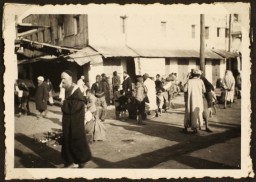
Children stand at attention during a flag raising ceremony at the Ayindram Betar summer camp. Tunisia, North Africa, 1946.
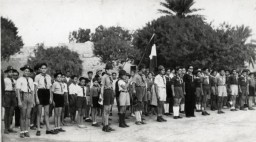
Prisoners at forced labor building airplane parts at the Siemens factory in the Bobrek labor camp, a subcamp of Auschwitz. February-June 1944. David Stein is pictured in the row to the right, with his back to the camera; his brother Charles is in the same row, fourth from the left, facing the camera.
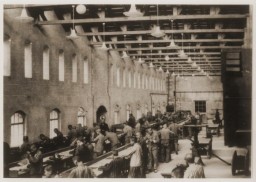
We would like to thank Crown Family Philanthropies, Abe and Ida Cooper Foundation, the Claims Conference, EVZ, and BMF for supporting the ongoing work to create content and resources for the Holocaust Encyclopedia. View the list of donor acknowledgement.